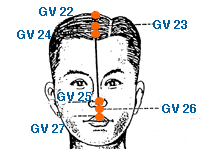GV 26
Acupuncture Point Theory
GV 26 Acupuncture Point Applications and Theory
 The acupuncture point "GV 26" , 人中, is represented by "Shui Gou" in pinyin and "Water Trough" in english and may be found:
The acupuncture point "GV 26" , 人中, is represented by "Shui Gou" in pinyin and "Water Trough" in english and may be found:
At the junction of the upper and middle third of the philtrum.
Of many possible clinical applications, it may be considered to influence the following issues/symptoms:
- One of two Command Points (with PC 6) added to the original four, for fainting, collapse. Main point for restoring consciousness, for shock, revivial from fainting, weakness, helps patient to awaken, use fingernail in an emergency.
- Main point for acute low back sprain, helps relieve pain and restore motion, moves stagnation at the opposite end of the channel. After obtaining the Qi, have pateint bend then rotate the waist.
- Nosebleed, nasal discharge issues, problems with olfactory sensations (smell).
- Manic-depression and other strong shen disturbances, epilepsy (seizures).
GV 26 has some precautions to be considered (see our precautions list).
Avoid Moxa (MX)
Gv 26 has the following theoretical associations which serve as important guideposts in designing an effective treatment protocol:
- Ghost Point
- Intersecting Point of the Governing Vessel, Large Intestine & Stomach Channels
- Command Point
Explore gv 26 functional groupings theory - Command Point and/or Ghost Point, or read all point categories and related theory.
While not necessarily valid clinically, LI 19 (Sinus congestion. Nasal polyps, sores. Noseblee…), LI 20 (Loss of smell or taste, nasal discharge, any nose…), ST 3 (Local point - Twitching eyelids, pain a/or swelli…) and ST 4 (Facial pain - Bell's palsy, facial paralysis, tri…) are nearby.
All Content 1999-2025
Chad J. Dupuis / Yin Yang House
Our Policies and Privacy Guidelines
Our Affiliated Clinics
